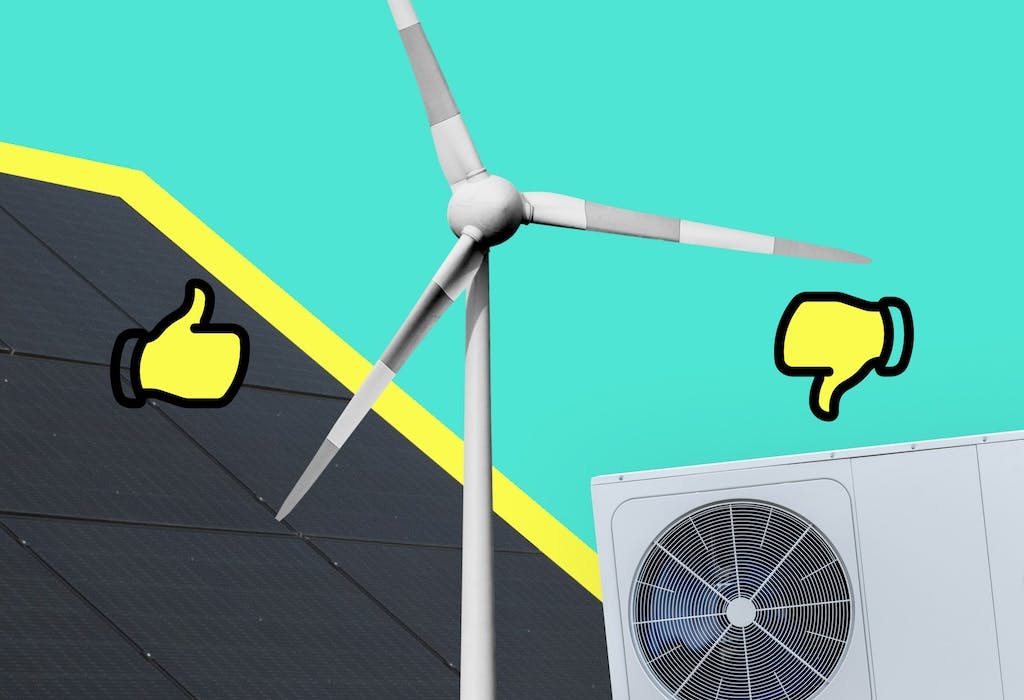The advantages and disadvantages of renewable energy
Learn about the key benefits and drawbacks of renewable energy, from costs and versatility to carbon emissions.
Written byMelody Abeni

🛢️ By 2050 all forms of renewable energy are set to be cheaper than fossil fuels
🌍 Renewables promote greater global energy independence
🏭 Green tech still generates carbon emissions during its manufacture
With the growing concerns over climate change and the depletion of the Earth's finite natural resources, the need for sustainable sources of energy has become more urgent than ever.
Renewable energy offers a promising path towards a more environmentally friendly and self-sufficient energy system. But it's not without its challenges and limitations.
Read on as we explore its benefits and potential drawbacks.
What are the advantages of renewable energy?
Renewable energy offers significant advantages, especially when it comes to sustainability, low costs, and its wider economic boost for local communities.
Let's look at these benefits in more detail.
1. It's cheaper than fossil fuels
Renewable energy sources (like solar and wind power) are already cheaper than fossil fuels. What’s more, prices for all renewables are falling yearly, making it an ever more cost-effective option for businesses and consumers.
In 2022, around 86% of new renewable power installations in G20 countries had lower costs than the cheapest fossil fuel option (IRENA, 2023), and it's projected that almost all power installations will be cheaper with renewables by 2050.
This has also had a snowball effect on small-scale renewables - particularly in the case of residential solar panel costs, which have tumbled dramatically since 2010.
When it comes to the cheapest form of renewable energy, the winner is solar - coming in at $876 per kilowatt in 2022.
Average cost of renewable energy per kilowatt, by type
2. It won’t run out any time soon
It’s all in the name; renewable energy sources like solar, wind, hydroelectric, tidal, and biomass don’t run out.
Solar energy uses sunlight, wind energy uses air currents, hydroelectric power uses river flow, tidal energy uses the moon and sun's pull on tides, and biomass energy uses organic matter like plants.
These sources are always available, though their availability can depend on the season, location, and technology (more on that below).
Despite the common misconception, it's important to note that nuclear energy isn't a renewable energy source. It relies on a specific type of uranium, which is a finite resource that's only mineable in certain places.
Previous estimates have suggested there's only enough of said uranium to power the Earth for around 230 years at the current rate of consumption. But research and development efforts are exploring alternative sustainable fuel sources, such as thorium, for nuclear reactors.
3. It doesn’t produce any carbon emissions once it’s operational
Except for biomass, which is considered ‘carbon neutral’ (although there are debates about this term), renewable energy sources produce no carbon emissions once up and running.
In contrast, the global carbon emissions from burning fossil fuels currently amounts to 34 billion tonnes per year. It’s roughly 45% from coal, 35% from oil, and 20% from gas.
4. It provides countries with greater independence
Unlike oil and gas, renewable energy sources are widely and readily available worldwide, so countries can generate their own energy and reduce their dependence on imported fossil fuels. Not every country can extract gas and oil if they don’t have natural reserves, but every country has wind, sunshine, and water.
This independence is especially important for protection against the sudden price changes and supply issues that can happen during global conflicts and natural disasters, as we've seen in Europe and in the Middle East.
The transition to renewable energy can also help communities by creating employment opportunities and stimulating local economic growth. New solar and wind farms need local installation, operation and maintenance, which provides opportunities for upskilling and training.

What are the disadvantages of renewable energy?
On the other side of the coin, renewables come with some disadvantages.
Here's a closer look at some of its drawbacks.
1. It can be inconsistent for energy generation
Renewable energy production can vary based on the source and season. Solar is less effective in the winter (and obviously useless in the dark), while wind speeds and river flow can change throughout the year. Most of northern Europe can sometimes be hit by dunkelflaute events, which are periods of low wind and little sunlight, and this can make it tricky for solar panels and wind turbines to be effective.
Tidal energy is more reliable since tides happen twice a day, but it's significantly more expensive compared to other sources of renewable energy. It can also be challenging to find suitable locations for projects because of its potential harm to biodiversity.
Biomass energy also needs a continuous supply of organic matter, which can lead to deforestation around the world. In 2023, biomass was the second largest source of renewable energy in the UK after wind power, contributing to 5% of the total electricity supply.
The best way around this is to use a mixture of renewable energy sources, so that if one isn’t working particularly well, others can step in. For instance, a country can’t run on solar farms throughout the winter, so wind farms can provide backup.
It’s also vital that the global switch to renewable energy makes use of battery storage. This enables countries to store up excess electricity, ready for use in emergencies when there simply isn’t enough new electricity generation.
2. It has a carbon footprint in the production stage
Renewable energy systems aren't completely clean. Although they barely release any carbon once operational, they accumulate a carbon footprint during their production and installation.
However, all renewable energy systems will eventually ‘break even’ on their carbon emissions, as once they’re up and running their impact on the planet is entirely carbon positive.
In contrast, power plants running on gas and oil will never break even - they release carbon emissions during manufacture, and then they release more carbon emissions as they generate electricity.
3. It takes time to implement
Using renewable energy is a smart way to make our energy system cleaner and more sustainable. But, it's not a quick solution - setting up projects like solar farms or wind farms can be a lengthy process.
Projects have to comply with many local rules and regulations to make sure they're safe and eco-friendly. This also involves the time-consuming, but necessary, process of consulting with local communities to make sure they're on board with any plans.
4. Opinions are mixed when it comes to aesthetics
Wind turbines don't exactly blend into the landscape, especially when there's a cluster of them. Similarly, solar panels can change the look of buildings and environments, which some people feel strongly against - particularly in the case of conservation areas and on listed buildings, which require planning permission for solar installations.
Hydroelectric dams can change rivers and create reservoirs, which can disrupt the natural environment. And biomass power plants take up a lot of space, produce smoke, and are often associated with environmental threats to forestry and agriculture.
For those concerned about an area's natural beauty, these imposing structures are hardly seen as a welcome addition. However, the industry is developing options that blend in better with their surroundings, such as solar tiles.
Ultimately, everyone has their own idea of what looks good. While some might not like the look of these energy sources, others might see them as signs of progress towards a cleaner and more sustainable future.
Summary
The main advantage of renewable energy is its minimal carbon footprint. The human race has a voracious appetite for electricity - more so than ever before - and renewable energy can feed this appetite without damaging the planet.
It also never runs out, meaning we can draw as much energy from the sun, the wind and the tides as we like.
However, no single source of renewable energy is a solution to climate change. If a country built huge solar farms but then encountered cloudy days, it would need to fall back on gas and oil. The solution is to build a variety of solutions - alongside storage facilities - in order to achieve a full shift away from fossil fuels.

Written byMelody Abeni
Based in London, Melody is a specialist green technology writer who has been covering sustainability, climate action and ESG for the past five years, after gathering operational experience in green investing and financial services. She has written for various industry publications, including renewable technology advisor The Eco Experts, and she holds a Master’s degree in law from Birkbeck University.